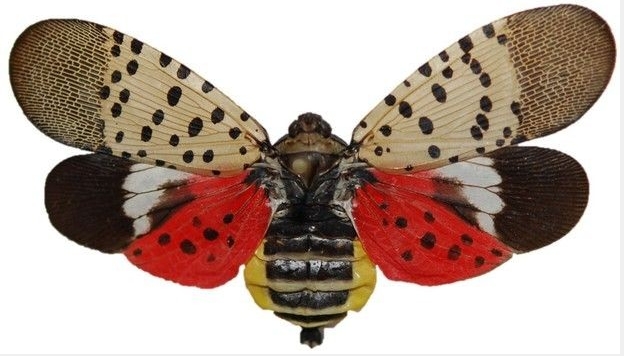
Features
Chemicals
Insects
Spotted lanternfly discovered in NY, PA
December 8, 2017 By Cornell University
 Adult spotted lanternfly. Pennsylvania Department of Agriculture
Adult spotted lanternfly. Pennsylvania Department of AgricultureDecember 8, 2017, Ithaca, NY – The New York State Department of Agriculture and Markets recently confirmed that the spotted lanternfly – an invasive insect originating in East Asia – has been found in New York state.
This invasive pest has also been discovered in Pennsylvania and other states, and is a potential threat to important agricultural crops, including grapes, apples, hops and forest products.
According to the Canadian Food Inspection Agency (CFIA), the pest is not known to occur in Canada and is not yet on Canada’s list of regulated pests. However, it may appear in Canada. Any producers who believe they have found suspect specimens are urged to please contact the CFIA.
Tim Weigle, statewide grape and hops integrated pest management specialist with the New York State Integrated Pest Management Program, works with grape and hop growers in implementing research-based IPM practices in environmentally and economically sustainable ways. He says the spotted lanternfly could rapidly expand its range by laying eggs on motor vehicles.
“The name spotted lanternfly is a bit misleading as this plant hopper grows to one-inch in size as an adult,” he said. “Large groups of both the immature and adult stages of laternfly feed on plant stems and leaves from early spring to September, weakening and possibly killing the plant. They also excrete a sugary, sticky substance similar to honeydew, which leads to the growth of sooty mold on grapes, apples and hops making them unmarketable.
“I would be concerned about any shipments that people are getting that originated in the Pennsylvania counties that are currently under quarantine. While this pest seems to prefer tree of heaven, it appears to be able to lay its eggs on any smooth surface like cars, trucks, tractors or stone. Therefore, the major traffic corridors coming up into the Hudson Valley and Finger Lakes area will probably have a greater potential for spotted lanternfly eggs being transported in due to vehicle traffic.”
Elizabeth Lamb, coordinator for the ornamental integrated pest management team for the New York State Integrated Pest Management Program says that grape, hop and ornamental growers, along with tree-fruit producers, are most likely to be impacted by this invasive pest.
“The industries most likely to be affected by spotted lanternfly in New York state are grapes and hops, tree-fruit production, and ornamentals,” she said. “Once you consider the ornamental hosts, it becomes an issue for homeowners and landscapers, too. So the first and most important piece in controlling spotted lantern fly is observation and monitoring – by growers and the public.
“A small bright spot: the biology of the insect provides several avenues for using different methods of control. Egg masses can be scraped off the smooth surfaces where they are laid and then destroyed. Nymphs crawl up and down tree trunks to feed so they can be caught on sticky traps at the right time. Adults have a preference or requirement for feeding on Ailanthus trees (Tree of Heaven), so the Ailanthus can be used as ‘trap’ trees where pesticides are applied very specifically to control the insect without widespread use.”
Print this page